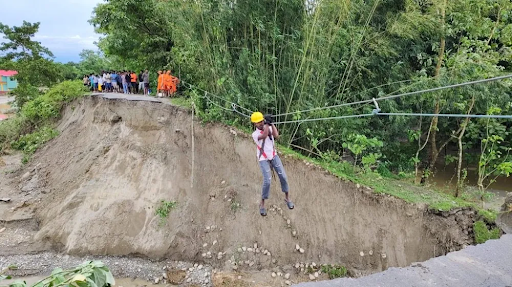Description

Disclaimer: Copyright infringement not intended.
Context: Centre has no plans to include heat wave as ‘notified disaster’: Union minister tells Parliament
Details
What is a Disaster?
According to the Disaster Management Act, 2005 a disaster is defined as-
- A catastrophe, mishap, calamity or grave occurrence in any area, arising from natural or manmade causes, or by accident or negligence which results in substantial loss of life or human suffering or damage to, and destruction of, property, or damage to, or degradation of, environment, and is of such a nature or magnitude as to be beyond the coping capacity of the community of the affected area.
- The Ministry of Home Affairs has defined a disaster as an “extreme disruption of the functioning of a society that causes widespread human, material, or environmental losses that exceed the ability of the affected society to cope with its own resources.
What are notified disasters?
- If such an disaster happens, then the provisions of the Disaster Management Act can be invoked.
- The provisions allow states to draw money from the two funds that have been set up under this law — the National Disaster Response Fund (NDRF) at the national level and the State Disaster Response Fund (SDRF) at the state level.
- The states first utilise the funds available in the SDRF, and only if the magnitude of the disaster is unmanageable with the SDRF, states seek the money from the NDRF.
- While the entire money of the NDRF comes from the central government, states contribute 25% of the money in the SDRF (10% in case of special category states), the rest comes from the Centre.
- The money in these funds cannot be used for any purpose other than response and management of notified disasters.
- Currently, there are 12 categories of disasters which are notified under this Act. These are:
|
Nationally Notified Disasters
|
|

Flood
|

Landslide
|
|

Drought
|

Cyclone
|
|

Earthquake
|

Cloud Burst
|
|

Hail Storm
|

Tsunami
|
|

Fire
|

Pest Attack
|
|

Cold Wave/Frost
|

Avalanche
|
|

Covid 19
|
State Disaster Response Fund
- The SDRF is constituted under the Disaster Management Act, 2005 and is the primary fund available with state governments for responses to notified disasters.
- The Central government contributes 75 per cent towards the SDRF allocation for general category states and UTs, and over 90 per cent for special category states/UTs (which includes northeastern states, Sikkim, Himachal Pradesh and Uttarakhand).
- For SDRF, the Centre releases funds in two equal instalments as per the recommendation of the Finance Commission.
Why heatwaves were not included as notified disasters?
- Heat-related illnesses and deaths have been common in large parts of northern, eastern and central India, these were not viewed as a disaster when the Act. It was because heatwaves were a common occurrence during summer, and not really an unusual weather event.
Why is the Centre not adding heatwaves as a notified disaster now?
Finance Commission Reluctance
- According to the 15th Finance Commission the existing list of notified disasters “covers the needs of the states to a large extent” and did not find merit in to include heatwaves.
- It endorsed an enabling provision created by the preceding Commission that allowed states to utilise at least a part of the SDRF money — up to 10% — for “local disasters” such as lightning or heatwaves, which states could notify on their own.
- Using this new enabling provision, at least four states — Haryana, Uttar Pradesh, Odisha, and Kerala — have added heatwaves as local disasters.
Practical Difficulties
- A notified disaster is the potentially huge financial implication.
- The government has to provide monetary compensation — Rs 4 lakh — for every life lost because of a disaster that is in the notified list.
- In 2024 more than 500 heat-related deaths have already been reported.
- In most cases, heat itself does not claim lives. Most people die due to other pre-existing conditions, made worse by the impact of extreme heat.
Benefits of Inclusion
- Inclusion as a notified disaster can improve the management of heatwaves.
- Heat-related illnesses and deaths would be better reported.
- Authorities would be more alert to minimise the impacts of heatwaves.
Heat waves: https://www.iasgyan.in/daily-current-affairs/heatwaves-30#:~:text=A%20heat%20wave%20is%20declared,C%20or%20higher%20than%20normal.
Humid Heat Waves: https://www.iasgyan.in/daily-current-affairs/humid-heat-waves-in-india
Sources:
https://www.downtoearth.org.in/natural-disasters/centre-has-no-plans-to-include-heatwave-as-notified-disaster
NDMA
Indian Express
|
PRACTICE QUESTION
Q. What do you mean by heat waves? Discuss the reasons and impact of the rising frequency and intensity of heat waves across India. Also, suggest some measures to mitigate its effect. 200 words
|














